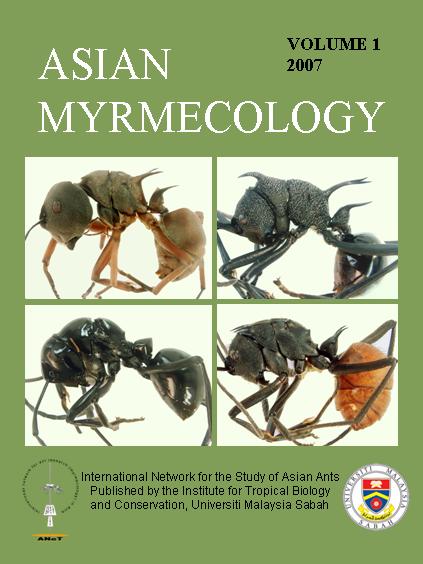ASIAN
MYRMECOLOGY
Image: François Brassard
Behaviour
Asian Myrmecology, Volume 1, pages 105-119, published August 2007
DOI: 10.20362/am.001010
Trophobiosis in a tropical rainforest on Borneo: Giant ants Camponotus gigas (Hymenoptera: Formicidae) herd wax cicadas Bythopsyrna circulata (Auchenorrhyncha: Flatidae)
MARTIN PFEIFFER1* & KARL EDUARD LINSENMAIR2
Abstract:
Here we report on a trophobiotic association of the predominantly nocturnal giant forest ant Camponotus gigas (Latreille, 1802) with a species of Flatidae, Bythopsyrna circulata (Guerin-Méneville, 1844) observed in Kinabalu National Park, Sabah, Malaysia. We investigate task sharing of the ants and quantify their nutritional benefits. Bythopsyrna circulata, which had no morphological adaptation to trophobiotic interaction with ants and seems to be facultatively associated with ants, produced the largest quantities of honeydew reported up to now. Honeydew output of larvae was 24 mg/h, of adults 42 mg/h. Time intervals of honeydew secretion by the Flatidae were significantly shorter when Hemiptera were tended by ants. Camponotus gigas showed three behavioural patterns during tending of flatids: “collecting”, “secondary gathering” and “antennating from ahead”. Workers of C. gigas switched among different tasks, but usually performed one task over a longer period of time. All workers exchanged honeydew by trophallaxis, thus optimizing their load size (mean load 24.5 mg) before returning to the nest. Although total colony gain from this association was high at approximately 7.24 g honeydew per night, flatids were not guarded by majors of C. gigas and were not tended during daytime. In contrast C. gigas majors guarded the coreid bug Mictis (cf. longicornis Westwood) sp., an obligate myrmecophile, which is morphologically adapted to interaction with ants. These coreids excreted honeydew droplets at a faster rate than flatids; yet assessment of total output of honeydew was not possible.
Keywords:
behaviour, Fulgoromorpha, Homoptera, honeydew production, Myrtaceae, plant hoppers, polyethism, Syzygium tree, trophobiosis
Get PDF (773K):
1University of Ulm, Institute of Experimental Ecology, Albert-Einstein Allee 11, 89069 Ulm, Germany
2University of Würzburg, Department of Animal Ecology and Tropical Biology, Am Hubland, 97074 Würzburg, Germany
*Corresponding author: martin.pfeiffer@uni-ulm.de



